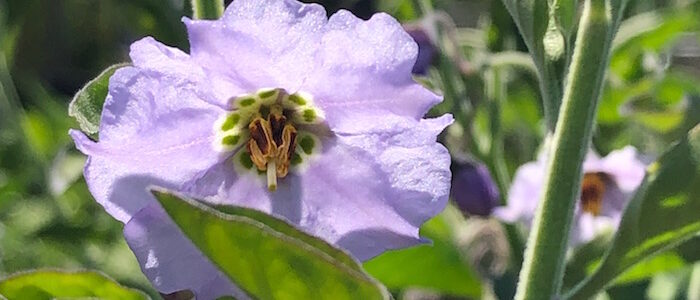
The nightshade family or Solanaceae is familiar to most of us: tomatoes, eggplants, and most sweet and hot peppers are closely related to blue witch. Unlike our cultivated culinary classics, Solanum umbelliferum is not edible to humans or pets (in fact, it is highly toxic if ingested). Its fruit however, are a great treat for many visiting and resident birds. Even though the nightshades offer no nectar they are visited by bumblebees and a few other native bee species capable of “buzz pollinating” the flowers. Numerous moth species use blue witch as a larval host plant. This is especially important if you are trying to attract beneficial organisms into your garden, helping support local ecosystems. Moth (and butterfly) caterpillars are an important source of protein for our avian neighbors. It has been said that deer will choose other plants over Solanum if they are not too hungry.
On a mid-winter hike, before most plants start to bloom, you may have had the pleasure of spotting a spray of purple flowers vining up through the shrub layer. I’ve also seen blue witch mounded singularly upon the sheer slopes of a coastal bluff in the heat of early summer, still showing off their distinctive colors long after peak wildflower season. Depending on conditions, the bloom period for blue witch can extend from winter all the way through mid-summer. If you haven’t had the honor, look for grey-green stems poking up through chaparral and northern coastal scrub, or along the edges and openings of oak and mixed evergreen woodlands.
You can be sure you’ve found blue witch by taking a close look at the flower. There you’ll find two tell-tale green spots at the base of each fused petal. These spots are generally ringed by a white halo. The flowers are a little less than an inch across, rounded, purple-blue and made up of 5 fused petals with large orange/yellow anthers surrounding a single pistil. The fruit (a true berry) resembles a tiny green tomato ripening to purple/brown or black. This summer deciduous sub-shrub has a loose branching habit often twining up through the branches of another shrub, though it can also be found growing in a dense mound. Blue witch is pleasantly fragrant.
In a garden setting, S. umbelliferum will need moderate to good drainage and full-sun (at least in the winter). Given the open growth habit of blue witch, it is most effective when planted among other shrubs allowing hairy grey-green branches to pop up here and there dangling flower clusters in unexpected places. The companion plants you chose will depend upon where you live. Here on the central coast this interesting nightshade can be planted with toyon, coffee berry, sagebrush, California lilac, cream bush and bush monkey flower. Grey-green foliage creates an interesting color contrast against other more common darker shades of green. Blue witch tolerates a range of soil-types, and is drought tolerant. Watering once per month through the summer will encourage a longer bloom period and a fuller looking plant. Once established, this plant will survive fairly harsh conditions with little to no summer water.
Fun fact: Solanum umbelliferum hybridizes with two other native purple flowered nightshades, S. xanti and S.parishii. Taxonomists remark that these species need more study to fully understand the differences between the three.
Adder Schlosser for Oaktown Native Plant Nursery
Information put together using our personal libraries of California floras and herbal medicine books, as well as Wikipedia, Calscape, Calflora, and UC Jepson websites.